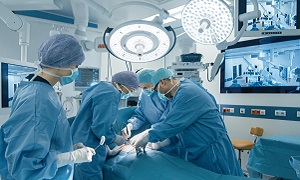Tummy Tuck
Tummy tuck also termed as abdominoplasty, is a cosmetic surgical procedure for flattening the abdomen by removing extra fat and skin; to improve its appearance. It tightens the walls in the abdominal area. Although it is different from liposuction, one can choose to get liposuction along with a tummy tuck.
You can choose to go for this procedure if you have excess fat or skin around the area of your belly button or a weak lower abdominal wall. A tummy tuck also helps to boost your body image.
Purpose
People can choose to go for a tummy tuck for a number of reasons. People with excess fat or poor skin elasticity or weakened connective tissue in the abdomen usually choose this procedure. These conditions are usually caused by significant changes in weight, pregnancy, abdominal surgery or aging.
Along with removing loose and excess skin and fat, it can also remove stretch marks and excess skin in the lower abdomen below the belly button. A tummy tuck however won’t be correcting any stretch marks outside of this area.
This procedure can also be combined with other contouring cosmetic procedures such as breast surgery. You can also consider this procedure after you have liposuction, as liposuction only removes the tissue under the skin and fat but not any excess skin.
It is to be noted that everyone isn’t the right candidate for a tummy tuck. Your doctor might caution against it if you are planning to lose a significant amount of weight, have a severe chronic condition, like diabetes or heart disease or if you have had a previous abdominal surgery which caused significant scar tissue.
Preparation
Initially, you will need to talk to a plastic surgeon about the procedure. A surgeon will likely:
Review your medical history- You will need to answer questions about your current and past medical conditions. You need to inform your surgeon if you are taking any medications or have taken any recently. Discuss any surgeries you have had as well.
Discuss your expectations- It is important to explain to your doctor why exactly you want a tummy tuck and what you hope for in terms of appearance after the procedure. Please make sure that you understand the benefits as well as the risks before the procedure. Also keep in mind that any previous abdominal surgery might limit your results as well.
Do a physical exam- To determine your treatment options, your doctor will need to examine your abdomen. He/she might also need to take pictures of the abdomen for your medical record.
Before undergoing the procedure you also need to:
Stop smoking- Smoking decreases blood flow in the skin, thus, slowing down the healing process. It also increases the risk of tissue damage. Therefore, if you smoke, your doctor might recommend that you stop doing so before your surgery and during the recovery period.
Avoid certain medications- Few medications such as aspirin, herbal supplements and anti-inflammatory drugs will need to be avoided.
Maintain a stable weight- Ideally it is important to maintain a stable weight for at least 12 months before having a tummy tuck. If you are overweight, you will need to lose weight before this procedure. Any weight loss after the procedure might diminish the results.
Take medication to prevent complications- Shortly before the procedure, you’ll need to begin taking an anticoagulant for preventing blood clotting.
Arrange for help during recovery- Make plans with someone for driving you home after you leave your hospital and ask if they can stay with you for at least the first night of your recovery at home.
A tummy tuck is usually done in a hospital or sometimes at an outpatient surgical facility. During the procedure, you will be under general anesthesia, which will make you totally unconscious and unable to feel any pain. Sometimes, you also might be given a pain-relieving medication and be moderately sedated.
Procedure
The procedure can take from two to five hours depending on the technique being used.
With a complete tummy tuck, your surgeon will first make two incisions. The first one will be from the hip bone on one side to the hip bone on the other side of the body, which is near the public area. The other incision will be around the navel.
If you are having a partial tummy tuck, your surgeon will be making one or two smaller incisions. This can be done laparoscopically or via an open procedure.
Once the incisions are made, the skin is separated from the abdominal muscles. Excess fat is removed from the abdominal area.
If they are separated, the abdominal muscles might need to be pulled together and stitched into place. Then the separated flap of skin is stretched over the abdominal area; after this, excess skin is removed for a tighter appearance. If your surgeon included the navel in the incisions, it is reconstructed in a position where it can look natural.
Sometimes, a surgical drain might be inserted under the skin for collecting any excess fluid. This will be staying in place for many weeks before its removal. Next, the incisions are closed with sutures. A sterile dressing is then applied over the area as well.
After the procedure
Once the procedure is complete, your anesthesia is removed or reversed. If you have a tube in place to help you breathe, this will be removed so that you can breathe on your own before leaving the operating room.
Next, you will be taken to a post-operative area where your vital signs will be monitored. It will several hours before you will be able to get up and walk again. Generally, you can go home or stay in the hospital according to your plan prior to the surgery.
Recovery from any type of tummy tuck can take two weeks to two months. Generally, if you have a large wound and/or a significant amount of fat and skin removed, then your recovery will take longer, as compared to when you have a small wound and a smaller amount of tissue removed.
Risks
There are multiple risks and complications which are associated with the tummy tuck procedure. Some of the risks include:
- Swelling and pain around the surgery area
- Scarring
- Skin discoloration
- Seroma (fluid accumulation)
- Changes in skin sensation
- Bleeding under the skin flap (rare)
Before the procedure, it is always important that you discuss the possible risks with your surgeon.


